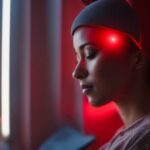https://www.youtube.com/watch?v=S5zmQCrcS80
Red light therapy, also known as low-level laser therapy, is a non-invasive medical treatment that uses red light of specific wavelengths to stimulate healing and regeneration of the body’s tissues. This therapy can aid in the reduction of pain, and inflammation, as well as improving skin health, and hair loss. In this article, we will explore why red light therapy works and its potential benefits.
The Basics of Red Light Therapy
Red light therapy is a non-invasive treatment that uses red light to penetrate the skin and stimulate the body’s natural healing processes. The red light wavelengths are longer than those of blue or green light, which means they can penetrate deeper into the skin. The therapy is also known as low-level laser therapy (LLLT), photobiomodulation (PBM), or biostimulation.
How Red Light Therapy Works
Red light therapy works by penetrating the skin and stimulating the body’s natural healing processes. The red light wavelengths are absorbed by the mitochondria of the cells, which then produce more energy in the form of adenosine triphosphate (ATP). This increase in energy helps the cells repair themselves and grow new tissue. The therapy also triggers the release of nitric oxide, which helps to increase blood flow and reduce inflammation.
The Benefits of Red Light Therapy
There are many benefits of red light therapy, including:
- Reducing pain and inflammation
- Improving skin health and reducing wrinkles and fine lines
- Increasing collagen production and improving skin elasticity
- Promoting hair growth
- Improving joint health and reducing arthritis pain
- Enhancing muscle recovery and reducing muscle soreness
- Boosting mood and reducing symptoms of depression
The Science Behind Red Light Therapy
Key takeaway: Red light therapy is a non-invasive treatment that works by penetrating the skin and stimulating the body’s natural healing processes. It triggers the release of nitric oxide, increases collagen production, reduces inflammation, and promotes hair growth. It is a safe and affordable treatment that can be used at home and in combination with other treatments.
The History of Red Light Therapy
Red light therapy has been used for centuries to treat various medical conditions, including pain, inflammation, and wounds. The ancient Greeks and Romans used sunlight to heal various ailments, and in the early 20th century, scientists discovered that red light could be used to stimulate the body’s healing processes.
The Research on Red Light Therapy
There is a growing body of research on red light therapy, with many studies showing its effectiveness in treating various medical conditions. In a 2014 study, researchers found that red light therapy was effective in reducing pain and inflammation in patients with knee osteoarthritis. Another study published in 2016 found that red light therapy was effective in treating chronic neck pain.
The Mechanisms of Red Light Therapy
The mechanisms of red light therapy are not fully understood, but researchers believe that the therapy works by stimulating the body’s natural healing processes. The therapy triggers the release of nitric oxide, which helps to increase blood flow and reduce inflammation. It also stimulates the production of ATP, which helps the cells repair themselves and grow new tissue.
Common Misconceptions About Red Light Therapy
One key takeaway from this text is that red light therapy is a safe and effective treatment that can stimulate the body’s natural healing processes. The therapy works by penetrating the skin and producing more energy in the cells, which can help to reduce pain and inflammation, improve skin health and elasticity, and enhance muscle recovery. While red light therapy has been used for centuries, there is a growing body of scientific research supporting its effectiveness. It is also becoming more accessible, with affordable devices now available for home use, and can be used in combination with other treatments and a healthy, balanced diet to enhance its effects.
Red Light Therapy is Dangerous and Can Cause Cancer
Red light therapy is a safe and non-invasive treatment that has been used for centuries to treat various medical conditions. Unlike UV light, which can damage the skin and increase the risk of skin cancer, red light therapy uses light wavelengths that are safe and do not cause harm to the skin.
Red Light Therapy is Expensive and Only Available at Spas
Red light therapy is becoming more popular and is now available in many different forms, including handheld devices, light panels, and full-body beds. The therapy is also relatively affordable, with many devices available for under $100.
Red Light Therapy is a Fad and Has No Scientific Basis
Red light therapy is a scientifically-proven treatment that has been used for centuries to treat various medical conditions. There is a growing body of research on the therapy, with many studies showing its effectiveness in treating pain, inflammation, and skin conditions.
How to Incorporate Red Light Therapy into Your Life
Using Red Light Therapy at Home
Red light therapy devices are now available for home use, making it easy to incorporate the therapy into your daily life. Handheld devices are perfect for treating specific areas of the body, while light panels and full-body beds are ideal for treating larger areas.
Combining Red Light Therapy with Other Treatments
Red light therapy can be used in combination with other treatments, such as massage, acupuncture, and chiropractic care. The therapy can enhance the effectiveness of these treatments and help to reduce pain and inflammation.
Red Light Therapy and Diet
Diet can also play a role in the effectiveness of red light therapy. Eating a healthy, balanced diet that is rich in antioxidants can help to boost the body’s natural healing processes and enhance the effects of the therapy.
FAQs for why red light therapy works
What is red light therapy?
Red light therapy involves exposing the skin to low levels of light, specifically red and near-infrared light wavelengths. This type of therapy is often used to reduce inflammation, improve skin health, and relieve pain.
How does red light therapy work?
Red light therapy works by stimulating the mitochondria in cells. Mitochondria are responsible for producing energy, and red and near-infrared light wavelengths have been shown to improve mitochondrial function. This improves cellular energy production and can lead to various benefits such as increased circulation, reduced inflammation, and improved healing.
Is red light therapy safe?
Red light therapy is generally considered safe when used as directed. It is non-invasive and does not produce heat or radiation that can damage the skin. Additionally, red light therapy does not cause any harmful chemicals or byproducts to be released into the body.
What are the benefits of red light therapy?
The benefits of red light therapy are numerous and can include reduced inflammation, improved skin health and tone, reduced pain, improved circulation, and improved recovery after exercise. It is also being studied for potential benefits in treating conditions such as osteoarthritis, depression, and even cancer.
How long does it take to see results from red light therapy?
The time it takes to see results from red light therapy can vary depending on the condition being treated and the individual’s response. Some people may see results in just a few sessions, while others may require more treatments before seeing noticeable benefits. In general, it is recommended to undergo several sessions of red light therapy in order to achieve optimal results.
Can anyone use red light therapy?
Most people can safely use red light therapy, but it is always best to consult with a healthcare provider before beginning any new treatment. Some individuals with certain skin or medical conditions may need to avoid or modify the therapy to ensure safety and effectiveness.



.jpg)



